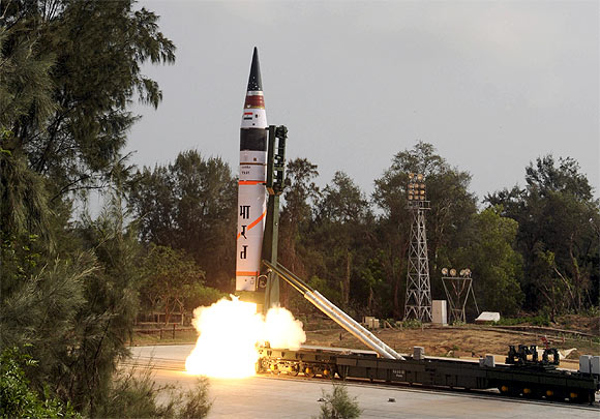BHUBANESWAR: India is set to conduct the first user trial of nuke capable intercontinental-range ballistic missile (ICBM) Agni-V signalling its early induction in the armed forces. Elaborate preparation has started at a defence facility off Odisha coast for the mission by the Strategic Forces Command of Indian Army. As per the schedule learnt by TNIE, the 5,000-km range missile is likely to be flight-tested on September 23.
Initially planned to be inducted in 2020 after the hat-trick pre-induction trials in 2018, the process was reportedly delayed due to Covid-19 pandemic that affected some important tests of the missile with multiple independently targetable reentry vehicles (MIRV). The mission has been planned close on the heels of the successful trial of Agni Prime missile, the first of the new class of Agni series of missiles, developed by DRDO. The three-stage solid-fuelled weapon with advanced guidance and new generation propulsion was fired with multiple independently targetable reentry warheads on June 28.
Defence sources said the next trial of Agni-V missile assumes significance as it may be equipped with the MIRV capable of carrying multiple warheads. Though the MIRV capability of the missile was secretly tested during a multi-satellite launch, no live launch has been conducted so far. “For the first time, the indigenous MIRV technology was tested successfully in Agni P missile with the weapon delivering two manoeuvrable warheads at two separate locations. The MIRV capability of Agni-V will give India the much needed deterrence,” said the sources.
While single-warhead missiles are generally launched against one target, the MIRVed missiles can dispense warheads against multiple targets. The technology will minimise the requirement of a number of missiles providing an edge in battle preparedness.A senior defence official said the induction process of the most potent game changer Agni-V has begun and the successful user trial would pave the way for its serial production. The canisterised missile is equipped with a ring laser gyroscope based inertial navigation system and micro inertial navigation system.
Developed by DRDO, the missile is capable of hitting targets in all Asian countries and parts of Africa and Europe. With a wiring of around seven-km, the 17-metre long, 2-metre wide, three-stage, solid-fuelled missile can carry a payload of 1.5 tonne and weighs around 50 tonne. India is the eighth country to have intercontinental ballistic missiles after the US, UK, Russia, China, France, Israel and North Korea.
Source: NIE
You may also like
-
IAF Aircraft Set Course For Exercise Eastern Bridge VII At Oman
-
IAF Set To Host The Indian Defence Aviation Exposition-II At Jodhpur
-
Defence Secretary to co-chair 5th India-Philippines Joint Defence Cooperation Committee meeting in Manila
-
Simultaneous Launch Of ‘malpe And Mulki’, Fourth And Fifth Ships Of Asw Swc (Csl) Project
-
Aatmanirbharta in Defence: MoD signs Contract with HAL for 240 AL-31FP Aero Engines for Su-30MKI Aircraft
